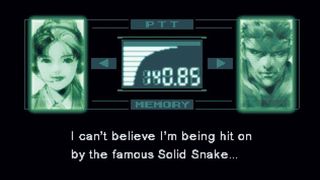T he Codec is the titanium-reinforced crutch of a series forever threatening to collapse under its mass of expository, acronym-laden dialogue. A direct line to Snake, Raiden, Big Boss and the player’s ears, the Codec offers a convenient means of dumping the vast swathes of information that never seem to get whittled out of Hideo Kojima’s scripts, and doesn’t even offer a cutscene chaser to wash them down. This use of the Codec reached its nadir in Metal Gear Solid 2: Sons Of Liberty, where characters standing opposite one another would switch to the Codec to protect themselves from ‘eavesdropping’. How could this work? They’re still standing in the same room, talking out loud. You can picture MGS2’s exhausted cutscene animators shrugging carelessly as they massage the cramps from their hands.

There are times when Konami and Kojima Productions seem to acknowledge that Codec scenes and their radio ancestors are a bore. MGS2 lets players subvert the seriousness of these dialogues by pressing buttons to zoom in on faces, or wiggle analogue sticks to move them. It’s a typical bit of silliness, but it did turn MGS into what its detractors glibly described as the series that encourages players to listen to endless conversations while twiddling their thumbs.
Still, as tempting as it is to dismiss the Codec, MGS’s radio conversations are – alongside cardboard boxes, exclamation points and giant robots – a crucial part of the series’ identity. More importantly, they’re the means by which the series comes closest to reconciling its love of scripted dialogue with its interactive nature. At least that’s true for the optional ones. Players keen to get on with the action may rarely bother with its extra functions, but the Codec can make calls as well as receive them. Snake was running about Shadow Moses with access to a set of contacts long before Rockstar handed Niko Bellic a mobile.
There are scores of games in which the protagonist embarks on a mission aided by a support team delivering context and instruction into his or her earpiece, but MGS lets you actively choose to call on that support, and even provides a basic logic to what you’ll hear and when you’ll hear it. Equip a gun and ring weapons specialist Sigint in MGS3 to hear an exhaustive rundown of its technical specifications as well as some more practical information. Enter a new location for the first time and you’ll be given a briefing on what to expect if you call your CO. Call up anyone during a boss fight and you’ll get relevant tactical tips or well wishes. There’s a kind of contextual dialogue system at play in MGS; it may have a mountain of script to scale, but it also weaves player-influenced and -instigated conversations into an action game without resorting to dialogue trees.

The Codec allows players to tailor their experience, choosing how much background information they want to embellish the story with, and how much help they receive. One character in the first Metal Gear Solid, Ukrainian weapons analyst Nastasha Romanenko, is entirely optional: Snake need never hear an accented word from her unless you decide to seek out more background info on nuclear armaments or want operational tips for your FAMAS assault rifle. Mass Effect’s extensive Codex arguably performs much the same expository role as the Codec, but the latter ensures that Snake, Big Boss or Raiden functions as the vehicle for your curiosity, and keeps information seeking hemmed inside the game’s present tense.
Kojima knew players would visit the Codec regularly, though, because it also functions as a save screen. Calling Mei Ling, Rosemary or Para-Medic to save your progress applies vast quantities of C4 to the fourth wall, but just stops short of detonating it. There’s something so reassuringly straight-faced about the way all three characters discuss the ‘mission data’ you’re storing that the act of saving progress becomes, thanks to the Codec, a simple bit of military protocol.
Unless, of course, you keep calling Mei Ling and refusing to save until she gets fed up and sticks her tongue out at you. That probably breaks protocol. But it wouldn’t be MGS unless the Codec was used for occasional levity, whether that’s Easter Eggs like Mei Ling’s anger, or overt digressions such as Para-Medic’s long-winded chats about movies. Yet the latter serve a thematic function, firmly establishing Snake Eater’s ‘60s setting despite the game’s jungle environment leaving Snake cut off from the prevailing culture.
Of course, the funniest Codec dialogues are the ones you have to work hardest to uncover: the throwaway conversations that occur when you push behavioural limits within the game, such as when you murder too many Huskies in Shadow Moses and get told off by your comrades. For a linear action series, MGS has always offered densely simulated environments, packing them with optional interactions and opportunities for mischief, and the Codec is an easy way for the game to acknowledge that, yes, it has taken notice of your attempts to break it.

It’s these silly, extraneous conversations that frequently feature the series’ best writing. Freed from explaining torturous double-crosses and convoluted plans, the Codec lets moments of human warmth and character seep into what are supposed to be lone-wolf sneaking missions. The Codec and the radio aren’t just MGS at its most indulgent, they’re its lifeblood-pumping heart.
Read more from Edge here. Or take advantage of our subscription offers for print and digital editions.

